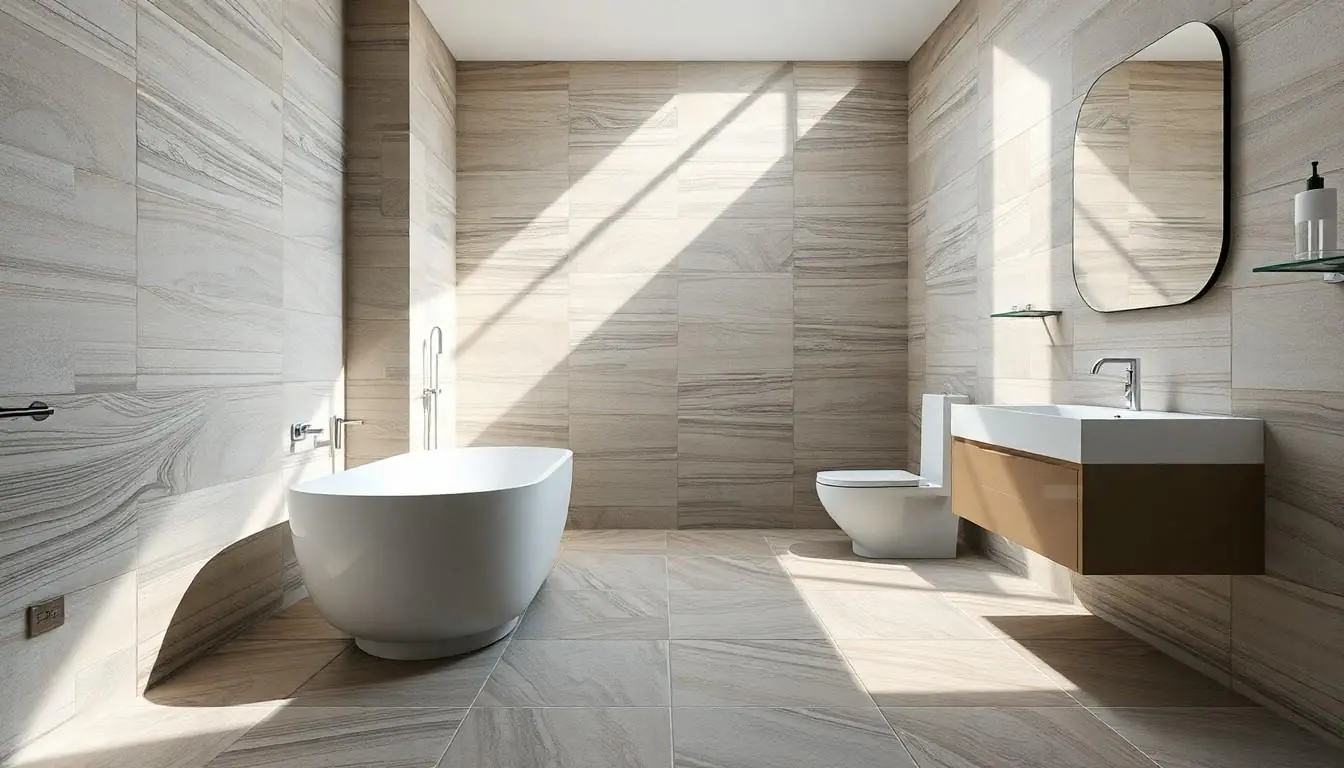Transforming a bathroom can feel like a daunting task, but choosing the right tile can turn that space into a sanctuary. Whether it’s a sleek modern vibe or a cozy rustic charm, the right tile can work wonders. Plus, who doesn’t want a bathroom that looks so good it could double as a spa?
Tiles aren’t just about aesthetics; they’re also about practicality. With options that resist moisture and are easy to clean, they’re the unsung heroes of bathroom design. Imagine stepping onto a beautifully tiled floor every morning, feeling like royalty in your own castle. So let’s dive into the world of bathroom tiles, where style meets function and every choice is a step toward your dream retreat.
Table of Contents
ToggleTypes of Tile for Bathrooms
Tile selection significantly influences a bathroom’s design and functionality. Various types exist, each offering unique qualities and styles.
Ceramic Tile
Ceramic tile features high versatility and affordability, making it a popular choice for bathrooms. It comes in numerous colors, patterns, and sizes. This tile type is moisture-resistant, which protects against water damage. Maintenance is simple, with regular cleaning required to maintain its appearance. Installation is straightforward, accommodating various designs and layouts.
Porcelain Tile
Porcelain tile stands out for its durability and water resistance. Denser than ceramic, porcelain resists moisture better, making it ideal for wet zones. Its aesthetic range includes finishes that mimic wood or stone, providing an elegant look. Maintenance remains easy, as it resists stains and scratches effectively. Installation options vary, allowing creative patterns across bathroom spaces.
Glass Tile
Glass tile brings a modern touch to bathrooms with its lustrous finishes and vibrant colors. Lighting can enhance its reflective qualities, creating a unique ambiance. Common choices include mosaic designs or larger format tiles for striking effects. While water-resistant, glass tile requires proper sealing to prevent moisture retention. Installation might require professional help due to its fragility during handling.
Natural Stone Tile
Natural stone tile offers an upscale look and unique variations. Materials such as slate, marble, and travertine create a luxurious atmosphere. Each tile presents distinct patterns, ensuring that no two pieces are alike. Regular sealing is essential to protect against moisture and staining. Installation techniques can utilize various layouts, allowing for personal expression in bathroom design.
Benefits of Using Tile for Bathrooms

Tiles serve essential purposes in bathroom design. They provide various benefits that enhance both functionality and style.
Durability and Longevity
Durability defines quality tiles. Ceramic and porcelain tiles resist moisture and wear, making them ideal for high-traffic areas. Many tiles endure heavy foot traffic without damage. Longevity adds value; quality tiles can last decades when installed properly. Homeowners can invest in tiles with confidence knowing these materials withstand daily use and remain attractive over time.
Easy Maintenance
Maintenance proves effortless with tiles. Simple cleaning requires just soap and water or a mild detergent. Stains typically wipe away easily, especially from porcelain and glazed tiles. Their resistance to mold and mildew reduces necessary upkeep in humid environments. Utilizing a regular cleaning schedule will keep bathrooms fresh and hygienic, ensuring they always look their best.
Aesthetic Appeal
Aesthetic appeal elevates a bathroom space. Tiles come in various colors, patterns, and finishes, allowing for creative designs tailored to personal tastes. Bold hues create dramatic atmospheres while neutral tones promote tranquility. Textured tiles add depth, complementing both traditional and modern styles. The versatility in design ensures that tiles can enhance any bathroom theme, making spaces feel inviting and stylish.
Choosing the Right Tile for Your Bathroom
Selecting the right tile transforms a bathroom’s overall look and functionality. Several key factors enhance this decision-making process.
Consider Your Bathroom Size
Bathroom dimensions impact tile choices significantly. Large bathrooms can handle expansive tile formats, creating a seamless appearance. Small bathrooms benefit from smaller tiles, allowing for intricate patterns that add visual interest. Utilizing lighter colors in compact spaces can visually expand areas, making them feel more open. Also, horizontal layouts can contribute to an illusion of spaciousness.
Color and Style Selection
Personal taste drives tile color and style choices. Neutral shades create a timeless backdrop while bolder colors add character. Coordinating tiles with existing fixtures reinforces a cohesive design. Patterned tiles make stunning focal points, potentially accenting walls or floors. Trends like geometric shapes and vintage looks showcase individuality and can invigorate classic aesthetics. Remember to consider the ambiance, as warmer tones lend coziness while cooler tones evoke freshness.
Slip Resistance and Safety
Slip resistance plays a crucial role in bathroom safety. Textured tiles offer improved traction, minimizing the risk of slips. Look for tiles rated for wet applications, ensuring compliance with safety standards. Manufacturers provide specific ratings to guide selections, which help in making informed decisions. Bathing areas often require more slip-resistant materials than around sinks or toilets. Prioritizing safety not only protects users but also enhances overall enjoyment of the space.
Installation Tips for Bathroom Tile
Installing bathroom tile requires careful preparation and technique. Proper steps ensure a long-lasting and visually appealing finish.
Preparing the Surface
Surface preparation is a critical first step in tile installation. Clean and level the substrate before applying adhesive. Remove any old material, such as paint or adhesive, to promote better adherence. When dealing with walls, use a cement backer board for added moisture resistance. Ensure the surface is flat, as irregularities can impact the tile alignment. Checking for any underlying issues, such as leaks or mold, prevents future complications. With a solid foundation, the installation process becomes more straightforward and effective.
Proper Adhesive and Grouting
Choosing the right adhesive is fundamental for ensuring tiles stay in place. Use a thin-set mortar specifically formulated for the type of tile being installed. For wet areas, consider a waterproof adhesive that better withstands moisture. Grouting is another key consideration; select a grout suitable for the installation environment, like epoxy grout for areas prone to heavy moisture. Properly mixing and applying grout fills the spaces between tiles, enhancing stability and preventing movement. Allow sufficient curing time before exposing the area to moisture for optimal results.
DIY vs. Professional Installation
Deciding between DIY and professional installation depends on skill level and project complexity. Experienced DIYers can install tiles with the right tools and preparation; however, some projects may exceed their expertise. When installing intricate patterns or large tile formats, hiring a professional can ensure precise results. Professionals also provide access to specialized tools, reducing potential errors during installation. Weighing the time, cost, and quality of the finished product helps determine the best approach for a successful tile installation.
Maintenance of Bathroom Tile
Maintaining bathroom tile ensures its longevity and aesthetic appeal. Regular care keeps tiles looking fresh and reduces the risk of damage.
Cleaning Tips and Products
Choose gentle cleaners formulated for tile surfaces. Use a microfiber cloth or a soft-bristle brush to avoid scratching. For daily upkeep, a mixture of water and a few drops of dish soap suffices. Avoid harsh chemicals that may degrade the grout. Specific products designed for tile can enhance shine and remove stubborn stains. Rinse tiles thoroughly after cleaning to prevent residue buildup. Consistently cleaning high-traffic areas, like near the shower or sink, prevents grime accumulation.
Preventing Mold and Mildew
Controlling humidity levels plays a crucial role in preventing mold. Bath fans should run during and after showers to reduce moisture. Utilize a squeegee after each use to limit water spots on the tiles. Grout sealer creates a protective barrier against absorbed moisture. Regularly inspect caulk and grout lines for cracks, as compromised seals allow mold to thrive. Keeping bathroom doors and windows open when possible promotes airflow. Selecting mold-resistant grout can further minimize concerns in wet environments.
Choosing the right tile for a bathroom can truly elevate the space both in style and functionality. With a variety of options available from ceramic to natural stone, homeowners can find the perfect fit for their design vision. Prioritizing factors like durability, slip resistance, and maintenance ensures a long-lasting and safe environment.
Investing time in selecting the right tiles and ensuring proper installation will pay off in the long run. A well-tiled bathroom not only enhances aesthetic appeal but also provides a comfortable and practical space for everyday use. Embracing the world of bathroom tiles opens up endless possibilities for creating a personal oasis at home.


